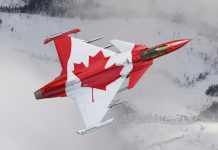Recent satellite imagery suggests that North Korea is close to completing its first-ever airborne early warning and control (AEW&C) aircraft, a major advancement that could significantly enhance the country’s military capabilities.
On March 4, 38 North, a website specializing in North Korea studies, reported that commercial satellite images had captured an Ilyushin IL-76 aircraft stationed at a Pyongyang airport.
The aircraft featured a large radome, a dome-like structure designed to house radar equipment, mounted on top of the fuselage, a clear indication that North Korea is developing airborne early warning and control (AEW&C) capabilities.
“This is a significant upgrade for an air force that has not seen new airborne capabilities in years,” 38 North reported.
The report added that the radome has a distinct triangular design on top, which is similar to certain Chinese Airborne Early Warning And Control (AEW&C) aircraft but unlike designs used by the United States or Russia.

This raises questions about potential foreign involvement in the project. While the triangular radome alone does not confirm Chinese assistance, it does suggest the possibility of some level of influence or support.
Another strong possibility is Russian involvement in North Korea’s AEW&C program. Since Russia’s full-scale invasion of Ukraine, Pyongyang and Moscow have strengthened their defense cooperation, with North Korea supplying Russia with over one million artillery rounds in exchange for potential military assistance.
If Russia is indeed helping North Korea develop airborne early warning and control (AEW&C) capabilities, the strategic implications could be profound.
An entry-level airborne early warning system would enhance North Korea’s ability to track enemy aircraft and coordinate its air defenses, even if it does not immediately match the sophistication of US or South Korean systems.
Over time, this foundational knowledge could also facilitate the seamless integration of the AEW&C aircraft with advanced Russian-made fighter jets or state-of-the-art air defense systems, should Moscow choose to supply them in the future.
North Korea’s AEW&C Aircraft
The aircraft visible in satellite images with a large radome was one of three IL-76s formerly operated by North Korea’s national airline, Air Koryo. In October 2023, it was transferred to a maintenance facility, and shortly afterward, a security barrier was constructed around it.
Modifications began on the top section of the fuselage by November 2023. The overhaul continued into 2024. In November, the aircraft was relocated to an adjacent hangar, where it remained until late February 2025.
At that point, it emerged from the hangar with the radome installed. But, North Korean state media has yet to acknowledge this development.
Jung Chang Wook, head of the Korea Defense Study Forum in Seoul, explained that the revamped aircraft is expected to monitor and track enemy movements and relay critical information to ground stations.
If it can also share this data with other air and ground units and help coordinate their operations, North Korea’s military response could become far more agile. “It’s like the North Korean air forces opening their eyes,” Jung noted.

He added that North Korea would need at least four such airborne early warning aircraft to ensure continuous 24-hour surveillance of South Korea.
This would allow them to alternate between active surveillance, routine maintenance, and training exercises. In comparison, South Korea already operates four US-built AEW&C aircraft and plans to expand its fleet with four additional units.
For the Korean People’s Army Air Force, known for its aging fleet primarily composed of Soviet-era jets and a handful of Western aircraft acquired under questionable circumstances, the addition of an airborne early warning and control platform is surprising.
Although its combat assets, such as the MiG-29 Fulcrum and older Shenyang F-5s (Chinese variants of the MiG-17), are far from modern, an AEW&C, even one based on an older airframe, could provide a substantial tactical upgrade.
Although North Korea’s capability to execute advanced battle management and command functions on such an aircraft is uncertain, the advantage of expanded airborne radar coverage is undeniable.
This capability could offer early warnings of potential attacks from South Korea or track incoming aircraft and missiles during the critical initial stages of any conflict.
Furthermore, the radar data could be relayed to surface-to-air missile units to increase their defensive readiness.
More importantly, it would act as a strategic tool for daily surveillance of Korean airspace, offering North Korea an opportunity to develop and refine its AEW&C expertise.
- Contact the author at ashishmichel(at)gmail.com
- Follow EurAsian Times on Google News




